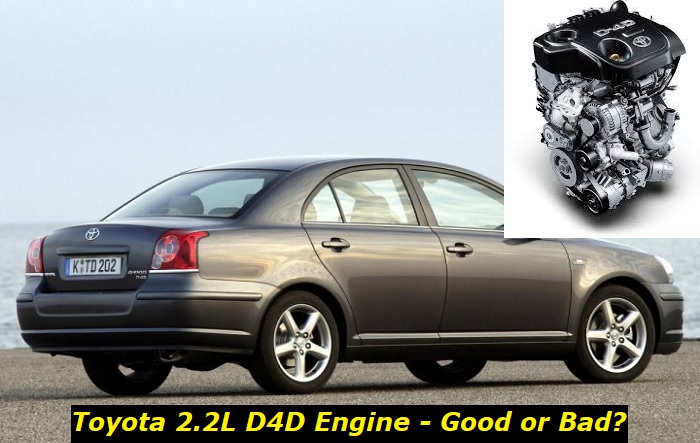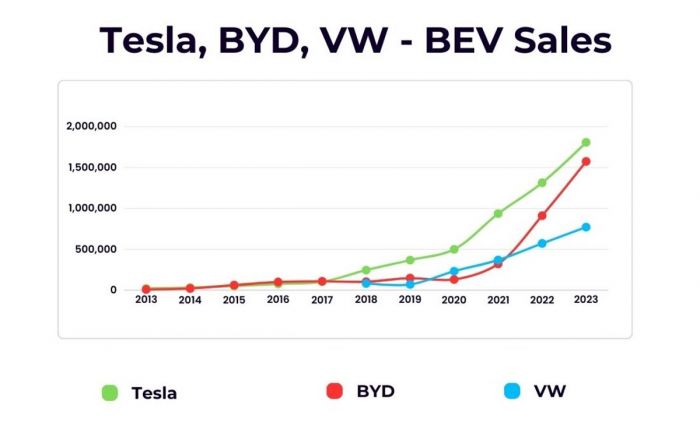Are you having trouble with your Toyota 2.2 D4D 2AD-FTV engine? Do you want to own one?
We cannot deny that Toyota has been known for producing quality engines.
So, when it comes to diesel engines, one with the most variations is the Direct Injection 4 Cylinder Common Rail Diesel Engine (D4D) engine family. This line of turbocharged engines with Common Rail Sytems can spray fine diesel mists at high pressure. What we love about the D4D is it produces power similar to petrol systems but is friendlier to the environment and has improved fuel efficiency.

Key features and my opinion about the engine
- Production years:2005-2018
- Average lifespan of 2AD-FTV:160,000-190,000 miles
- Fuel supply type:Common Rail
- Power range:136-150 hp
- Fuel efficiency:excellent
- Engine block material:aluminum
- Engine reliability score:medium
- The most common problems:faulty head gasket, oil consumption, tricky common rail system, DPF and EGR problems.
What Do I Need to Know About the Toyota 2.2 D4D Engine?
Toyota 2.2 L D4D engine, known as 2AD-FTV, is a 2.2-liter with four-cylinder heads turbocharged engines. Toyota produced these engines from 2005 to 2018. It produces 136 to 150 hp power and 229 to 266 lb-ft torque. It has a compression ratio of 15.7:1 to 16.8:1.
The engine features an aluminum body, cast iron sleeves, 16 valves with two camshafts overhead, hydraulic lifters, and a timing chain. Initially, the motor used solenoid injectors. But they replaced it with piezo injectors.
The cylinder bores measure 86 mm, while the piston stroke measures 96 mm. This measurement provides a displacement of 2231 cc. Inside the bores are spiny cylinder liners that create large uneven surfaces on casting exteriors.
This structure allows better heat transfer and decreases heat deformation, making it possible for the piston and cylinder to have a sliding surface and prevent piston-to-block contact. Also, you'll find coolant passages between the engine bores.
Toyota installed the engine in different models:
- Toyota Avensis 2 T250 (2005-2009)
- Toyota Avensis 3 T270 (2009 to 2015)
- Toyota RAV4 3 XA30 (2006 to 2012)
- Toyota RAV4 XA40 (2012 to 2018)
- Toyota Verso AR10 (2006 to 2009)
- Toyota Verso 1 AR20 (2009 to 2018)
- Lexus IS XE20 (2010 to 2013)
If you're considering a 2.2 D4D, know this engine has a mixed reputation. Enthusiasts knew the motor for its reliability, fuel efficiency, and environmental friendliness. The problems owners had to deal with this engine were so critical. The parts affected mainly are the head gaskets and cylinder heads, which were not adequate for recalling a batch.
The thought alone could lead you to a series of panic because your most probable solution is to replace the engine.
The engine has an estimated lifespan of 250,000 km or about 155,000 miles. However, the longevity of this engine still depends on maintenance, driving conditions, and driving habits.
What are the Problems of the Toyota 2.2 D4D Engine?
Although the engine was dependable and efficient in general, it was not exempted from having problems. Two of the most prevalent issues in this engine before were head gasket failures and oil consumption issues. However, Toyota has addressed most of these problems. They have offered those affected units an extended warranty. For engines seven years old or 111,846 miles.
1) Cylinder Head Deformations
The earlier materials used on the cylinder head of the 2AD-FTV are aluminum. It is a lightweight and durable material. However, the cylinder heads were so young, and the engine was so powerful.
The cast iron engine block and aluminum cylinder heads could expand while the engine heats up and cools down. However, the materials on the cylinder heads failed at some point. They warped and deformed until the event resulted in many engine problems that required engine replacements. This problem in the cylinder wall materials led to many issues, including blown head gaskets, coolant leaks, and oil leaks.
The good thing is Toyota addressed most of the cylinder head-related problems. They have thickened the cylinder heads and adjusted the torque specifications on the bolts so they can clamp better.
2) Head gasket problems
The earlier released Toyota 2.2 D4D engines are notorious for having head gasket failures. A lot of owners complained of having blown-up head gaskets. These owners had models from 2005 to 2008 and likely have had problems of this kind. Although they are small in numbers to declare a recall, some units experienced cylinder wall deformations and design flaws.
The head gasket between the cylinder head and the engine block seals the combustion chamber and maintains the required compression. However, Toyota later discovered that the materials used on cylinder walls were prone to warping, a reaction to overheating and high pressure. As a result, the head gasket blew up and led to different leak types.
In most cases where the problem occurred, the vehicle is under 70,000 miles. Some of them were around 35,000 miles.
Toyota replaced those engines approved for the extended warranty with ¾ engine assembly. This only means that the replacement is 75% complete. If you still have the original engine, it is already out of warranty. For the improved blocks in later model years, the manufacturer replaced the head gaskets with stronger material to withstand high temperatures and pressure.
3) Excessive Oil Consumption
Toyota 2AD-FTV owners also reported excessive consumption of oil. Most cases reported over .05 liter of oil consumed in over 600 miles. This oil consumption is unusual. Some 2.2 D engines used up 1 liter on 500 miles nearly every month.
Oil leaks were also a result of the cylinder head deformation we discussed earlier. Many factors contributed to higher oil consumption in this engine model: worn-out piston rings, damaged valve stem seals, or inappropriate oil use. If the engine has records of dismantling and reassembling before, it may cause excessive oil use.
Good thing Toyota included this problem in their extended warranty.
4) Diesel Particulate Failure
The 2AD-FTV comes equipped with Diesel Particulate Filter (DPF), which captures, stores, and removes particulate matter from the exhaust gases before being released into the environment. When the combustion is incomplete, it will produce soot or particulate matter.
The most common cause of producing excessive soot in the DPF is its design is not compatible with city driving. City driving requires frequent stopping and going. And the 2.2 D4D DPF design does not give enough time for the system to regenerate. With short driving cycles, the system cannot produce enough heat to trigger regeneration, causing more unburned fuel to build up.
Another reason the DPF may fail is when there are oil leaks or excessive oil consumption. Oil leaks were prevalent in 2.2 D due to its design flaws. Also, failure in the DPF may cause the vehicle to go into limp mode. Although the DPF is one of the marketable features of the 2.2 D4D engines, most owners wanted to remove this filter because it restricts the flow of exiting exhaust gas.
5) 5th Injector Failure
Up to this point, we can conclude that the 2.2 L D4D engine was known for building up soots in different parts of the engine.
The 5th injector is a post-injection system that triggers regeneration in the DPF. However, the fuel injector seal washers burn out often as it operates at high temperature, leading to unburned fuel and soot build-up. This blockage results in injectors failing to open or close when needed.
The blockages produced by the 5th injector failure reduced the engine performance, increased emissions, and caused engine damage.
Toyota has addressed this issue by updating the software and adding a cleaning cycle to prevent carbon build-up and help prolong the life of the injector.
6) Coolant Issues
The 2.2 D4D 2AD-FTV is also notorious for serious coolant issues, and the most affected component of the system is the Exhaust Gas Recirculation cooler. The EGR recirculates parts of the harmful gases back to the combustion chamber. To do this, the EGR utilizes a metal pipe connecting the EGR valve and exhaust manifold. However, its design exposes the metal tube to high temperatures. This exposure leads to the pipe cracking and leaking. With leaks, the coolant could mix with the exhaust gases.
Another problem with the EGR valve is the excessive build-up of soot carried by recirculated particulate matter and exhaust gases back into the engine.
Toyota modified the EGR coolers so the coolant does not seep through the system.
Symptoms of Toyota 2.2 D4D Engine Problems
Most of the problems above are interconnected with different parts of the engine. Toyota has addressed most of these problems even without a recall.
- Engine Misfires
- Excessive Smoke Emission
- Loss of Power
- Engine Overheating
- Strange Noises
- Difficulty Starting the Engine
Is Toyota 2.2 D4D reliable?
After all the problems enumerated in this article, we can still conclude that the 2AD-FTV or 2.2 D4D engine is reliable. It is normal for new blocks to have flaws in their early releases. If ever your Toyota got this engine from its early years, it is already out of extended warranty. Toyota has addressed these problems and even improved these parts. Although, you may still have to deal with issues with your DPF because the engine is turbocharged. This engine would still last up to its livable years of 250,000 km or 155,000 miles.
Is it the Best Diesel Engine in Japan?
Although we find this engine reliable, there are better diesel engines in Japan you may like to consider. For a country known for reliable car manufacturers, it is difficult to pinpoint which is the best. But we could note a few commendable diesel engines out there.
Even though Toyota has stopped developing diesel engines, it's worth noting the Toyota GD engines for their advanced technology: the Common Rail Injection System, the variable nozzle turbos, & EGR. They are known for enhanced fuel efficiency and low emissions. Think of Hilux and Land Cruiser.
We'd also like to mention the Mazda MZ-CD, known for being fuel-efficient with reduced or low emissions.
From Nissan, the YD engine is one of the most reliable diesel engines when it comes to durability and longevity.
But overall, you can rely on the performance of the 2.2 D4D. It has great engineering and Toyota has resolved most of its flaws.
About the authors
The CarAraC research team is composed of seasoned auto mechanics and automotive industry professionals, including individuals with advanced degrees and certifications in their field. Our team members boast prestigious credentials, reflecting their extensive knowledge and skills. These qualifications include: IMI: Institute of the Motor Industry, ASE-Certified Master Automobile Technicians; Coventry University, Graduate of MA in Automotive Journalism; Politecnico di Torino, Italy, MS Automotive Engineering; Ss. Cyril and Methodius University in Skopje, Mechanical University in Skopje; TOC Automotive College; DHA Suffa University, Department of Mechanical Engineering






Add comment